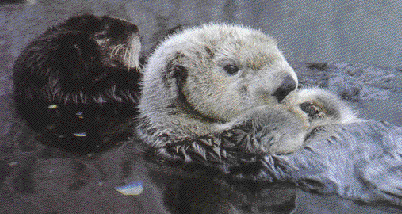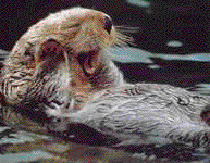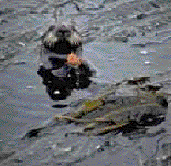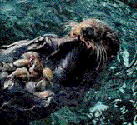| Sea Otters |
 |
Amazingly enough sea otters once roamed the shores from Alaska to Mexico, and even over in Japan. Now they can only be found from California to Alaska. Anchoring themselves on kelp they often like to float in shallow inlets.
Sea otters eat shellfish such as clams and abalone. They lie on their backs and pound the shells with rocks, using their flat chests as tables. Every day an adult sea otter may eat up to 30% of its own body weight. Sea otters are mammals, marine mammals, but mammals all the same, so pups need milk to survive. They are born with fur that holds so much air that they can not even dive for food. They take extra good care of their pups. Mother otters usually spend hours grooming their pups and carrying them around on their chests. Even though twins are not unheard of, usually there is only one pup. The gestation period is usually 4-5 months and pups can be born all year (however are usually born in February).

Because of the sometimes-harsh conditions at birth it is crucial that pups be strong, and have mothers to support them. Because stranded pups usually don't survive.
Sea otters are the smallest marine mammals. They unlike whales, seals and polar bears do not have blubber. However they do have 2 layers of fur. One layer is an under coat, and the other are guard hairs. Sandwiched between the 2 layers is and air pocket which makes the otter more buoyant in the water and keeps pups from sinking. In fact the otter its self is always totally dry. Sea otters fur is actually the thickest of any mammal. It is so dense that one sq. inch can have up to 1,000,000 hairs!
When full grown female sea otters can weigh 35-50 pounds while males can weigh up to 90. In Alaska sea otters tend to be larger, and males there can range up to 100 pounds.

Sea otters are endangered. Although they have had a fairly peaceful experience for the last few years there are still struggles in their survival. The two largest threats now are poaching and oil spills. Their unusual fur can bring in quite a lot of money and is a huge temptation to poachers. The Exxon oil spills in Valdrez Alaska, 1989, killed over 2,000 otters and left hundreds of pups stranded in human hands. So even though law protects these mammals they are still vulnerable.

Information
Pictures
| One World | home |
Sea Otters | Humpback Stranding | Bird Quiz | Right Whales | Shade Grown Coffee | Arctic | Basilosaurus | Antarctic Zebra(fiction)
Background artist: Alan Tupper